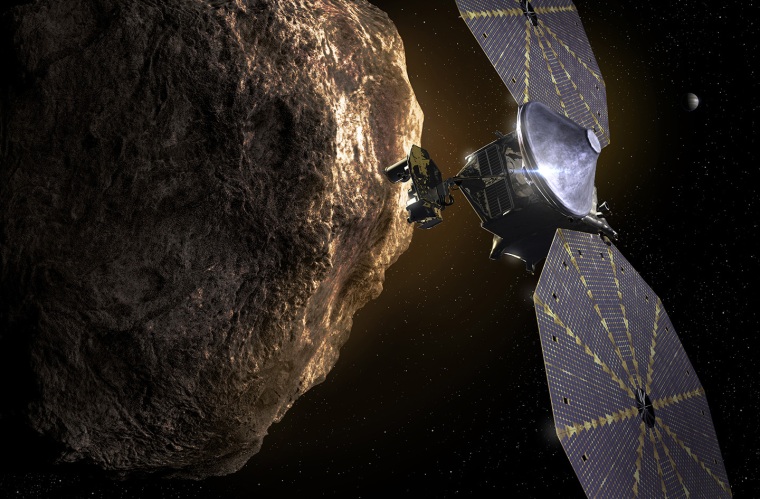Lucy in the Sky With Diamonds
"That's what we're doing with asteroids ['planetary archaeology'].""We're excavating the leftovers from the construction site [of the solar system]."Tom Statler, program scientist, NASA"One of the surprising things about the Trojan population is that they are physically very different from one another but occupy a really small region of space.""That diversity in that small region is telling us something important about the early evolution of the solar system.""My hope will be to look at the current models of solar system formation -- including my own work -- and say: 'Nope, this is all wrong. It wasn't that simple, and we have to start again'."Hal Levison, planetary scientist, principal investigator, Lucy mission, NASA
 |
NASA launches robotic archaeologist Lucy on 12-year mission to Trojan asteroids |
NASA is interested in discovering primordial organic material on asteroids with the prospect that they may have seeded Earth with the chemical ingredients required for life to emerge, billions of years ago. A 12-year mission has been launched, to be powered by two giant solar arrays in the form of a probe to reach clusters of asteroids along the orbital path of Jupiter. The spacecraft has been named Lucy, as has the mission in recognition of the 3.2 million-year-old australopithecine skeleton discovered in 1974 in Ethiopia, a discovery that revealed secrets of human evolution.
 |
Robotic Lucy's purpose is to reveal to astrophysicists the evolution of the solar system. The cluster of asteroids toward which Lucy is slated to reach in that ambitious project of archaeological revelations about the solar system's origins are called collectively the Trojan swarms, representing the unexplored regions of asteroids in the solar system. Lucy lifted off on her mission on October 16; a deep-space robotic archaeologist seeking to answer such pressing queries on the solar system origins; and how the planets reached their present orbits and how life could have emerged on Earth.
Lucy is slated after cruising through space for six years, to fly close to the seven Trojan asteroids through to 2033, through sun circuits to study the geology, composition, density and structure of the Trojans, small bodies in stable points along the orbit of the sun expressed by Jupiter. The concept of planetary formation thirty years ago was not what it is today. When then it was believed that a star formed in the center of a rotating disc of protoplanetary material to gradually condense and collect into eight planets in simple orbits.
Efforts by planetary scientist Hal Levison and others of his colleagues attempted to simulate the formation of the solar system, discovering repeated problems in their efforts -- finally resulting in the realization it was not possible to build Uranus and Neptune in their present orbits. Which led to the development by Dr. Levison and three other researchers of the Nice model of solar system evolution, suggesting the giant planets formed closer to the sun than current orbits would suggest. The increasingly eccentric orbits of the young Jupiter and Saturn destabilized, rearranging the solar system in the process.
| CAPE CANAVERAL, Fla. — NASA's newest asteroid probe, named Lucy, blasted off from Kennedy Space Center here in Florida to embark on a 12-year mission to study two different clusters of asteroids around Jupiter known as Trojans. These swarms represent the final unexplored regions of asteroids in the solar system. |
The giant planets moved and headed outward, scattering small bodies of the solar system some of which became the Trojan swarms of asteroids about 4.6 billion years ago; a system of planets circling a sun-theory. Lucy's trajectory is meant to carry it further than any solar-powered spacecraft, powered by two giant solar arrays, moving at about 10 kilometers each second. Its sophisticated orbit of loop-the-loops across the solar system, circling the sun, taking gravity from Earth for propulsion to Jupiter's orbital path at the Lagrange 4 point.
From there, gravity will point it again around the sun to the Earth whose gravity again will hurl it outward to Lagrange 5 and back, a process designed to repeat itself infinitely; a trajectory driven by planet positions and gravity assists, to enable the spacecraft to continue on for conceivably hundreds of thousands of years.
Lucy has been outfitted with a "time-capsule" of poetry, quotes and song lyrics; presumably inclusive of The Beatles' 'Lucy in the Sky With Diamonds' in celebration of the Ethiopian skull find named Lucy.
The hope and expectation is that at some time in the future, space-farers will come across Lucy, study its revelations and in the process make their own discoveries of life on Earth in the 21st Century.
The completed mission is meant to reveal the unexpected -- explaining how the solar system evolved.
 |
Labels: Lucy, NASA, Origins of the Solar System, Robotic Archaeological Mission, Spacecraft, Trojan Swarms

0 Comments:
Post a Comment
<< Home